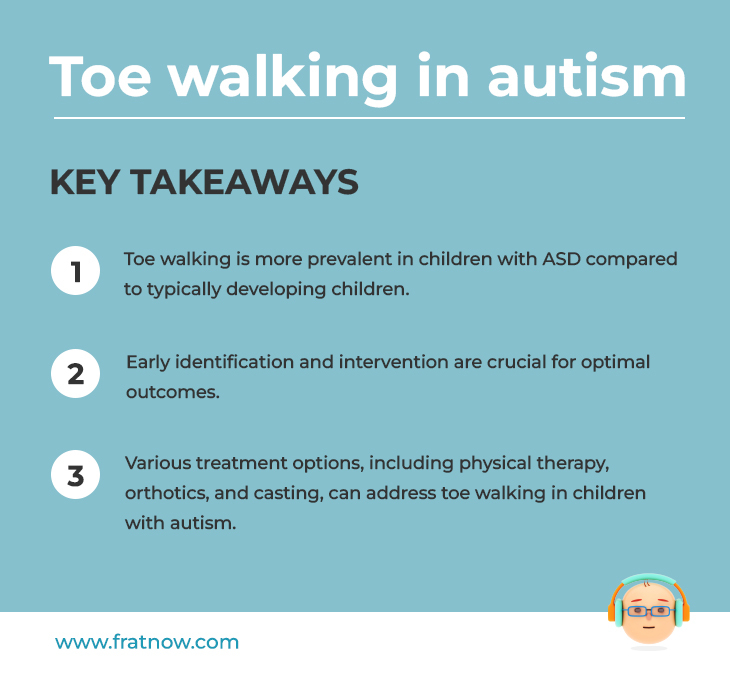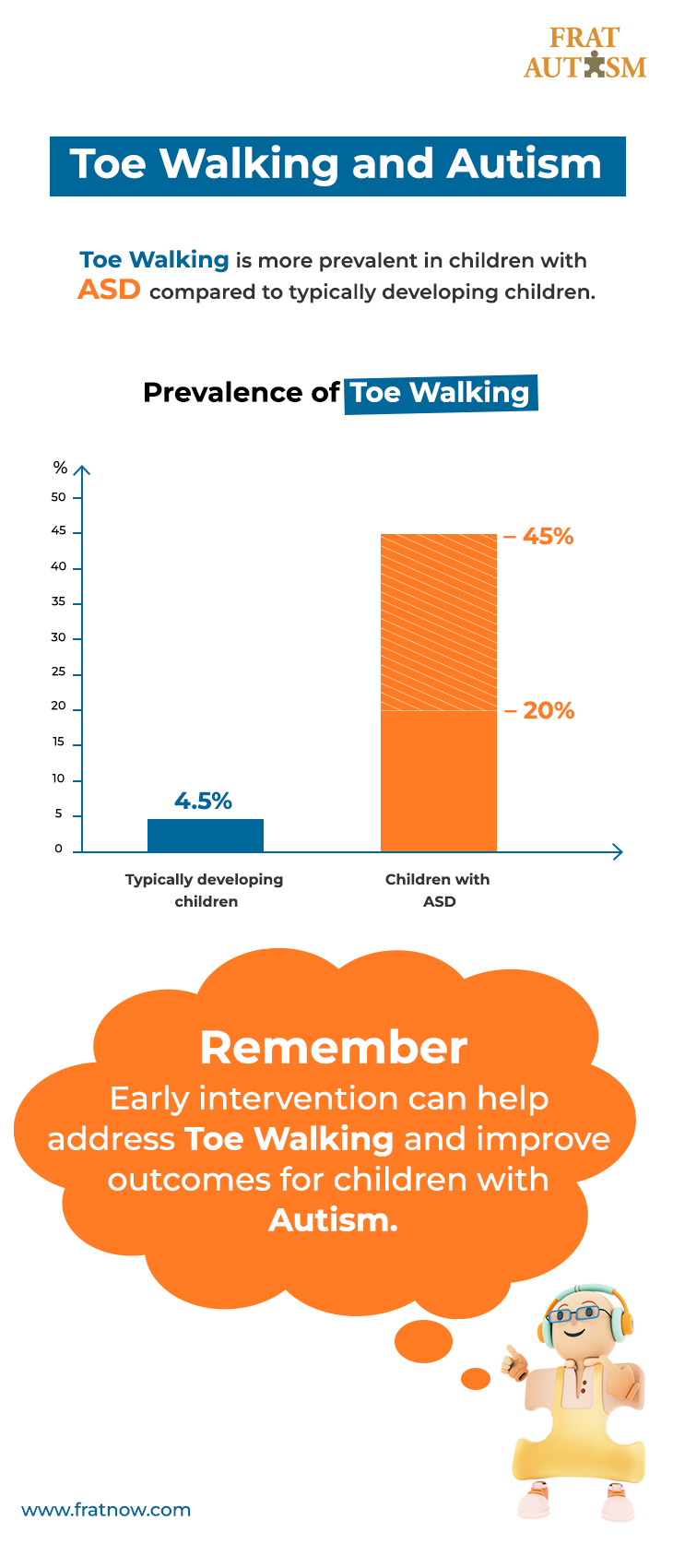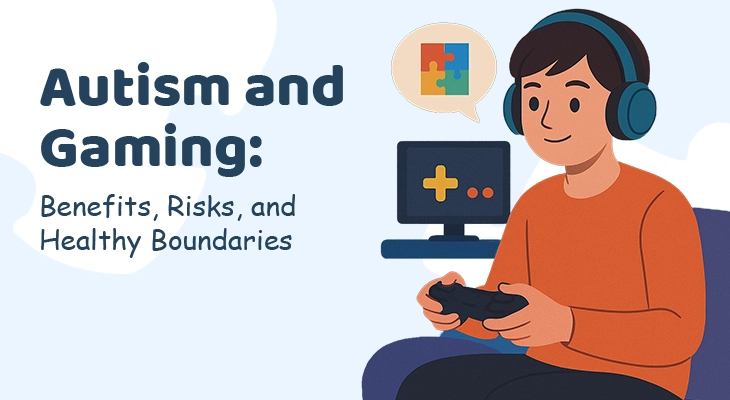
Download Download & share this Knowledge card in your network [Free Download]
What Is Toe Walking?
Toe walking is when a child walks primarily on their toes instead of their entire foot. Also known as walking on toes, it’s the inability of a child to make heel-to-ground contact during the initial developmental stages.
Toe walking is relatively common in toddlers who are learning to walk, and is considered a normal stage in gait development typically resolving between 3 to 7 years of age. However, if it persists beyond this age, it’s considered persistent toe walking and may be a sign of an underlying condition.
This blog post will explore various aspects of toe walking, particularly its link to autism spectrum disorder (ASD).
Table of Contents
What Underlying Medical Conditions Cause Toe Walking?
There are two main groups of problems that can cause toe walking:
- Brain or muscle problems: Some neurological conditions can affect muscle tone and coordination, leading to toe walking. These conditions include: Cerebral palsy, Muscular dystrophy, Charcot-Marie-Tooth disease, Spinal cord injury, Brain injury, Tethered cord, Spina bifida and Schizophrenia.
- Other problems: Additionally, there are other factors that can contribute to toe walking, such as: Idiopathic toe walking (no known cause), Autism spectrum disorder (ASD), Limb length discrepancy, Clubfoot, Tendon or joint contracture, Ankylosing spondylitis and Unilateral hip dislocation.
Is Toe Walking A Sign of Autism?
Toe walking, a gait pattern where individuals primarily walk on their toes, is commonly observed in children with autism spectrum disorder (ASD). As per the National Library of Medicine, toe walking is more prevalent in children with ASD compared to the general population, suggesting a potential link between the two conditions[1]. While the prevalence of persistent toe walking in typically developing children is only 4.5%, it’s substantially higher in children with autism, ranging from 20% to 45%.[4] While toe walking isn’t a part of the autism diagnosis, it can be a related problem.

Download Download & share this infograph card in your network [Free Download]
What Are The Underlying Causes Of Toe Walking In Autism?
Toe walking might be related to problems with the vestibular system, which is often affected in people with autism. A bad vestibular system can cause problems with:
- Knowing where your body is in space (proprioception)
- Moving smoothly
- Keeping your balance
This can affect how they move and stand. They might also have trouble with sensory things like seeing, hearing, and feeling. These things can all play a role in how they walk. Children with autism might also avoid touching the ground or other things. This can lead to toe walking, even when there’s no medical reason for it. Studies show that many people with autism have trouble with hearing and their vestibular system. This can lead to problems with planning movements, staying steady, looking at things, and toe walking.
Some experts think that children with autism might learn to reach for things in a different way than other kids. They might use their own body as a reference point instead of looking at the object.
How To Treat Toe-Walking In Autism.
While the exact causes may vary, addressing toe walking is essential for improving mobility, reducing pain, and enhancing overall quality of life. Various treatment options for correcting toe-walking in autism are mentioned below:
Physical Therapy
- Stretching exercises: Gentle stretching of the calf and foot muscles can help improve flexibility and range of motion.
- Proprioceptive training: Activities that help the child become more aware of their body’s position and movement can improve gait patterns.
- Gait analysis: A physical therapist can assess the child’s gait and provide specific exercises or techniques to address toe walking.
Orthotics
- Ankle-foot orthoses (AFOs): Custom-made braces can support the foot and ankle, encouraging a more normal gait pattern.
Serial Casting
- A series of casts applied to the leg can gradually stretch and lengthen the calf muscles, promoting a more natural foot position.
Botulinum Toxin Injections (Botox)
Injections of botulinum toxin into the calf muscles can temporarily relax muscle tension and improve ankle range of motion.
As per the National Library of Medicine, the “Cast and Go” protocol, involving botulinum toxin injections, serial casting, and rehabilitative therapies, has shown promising results in treating toe walking in children with autism. This approach aims to correct ankle contractures and improve gait patterns. The key findings of this study were:
- Effectiveness: The “Cast and Go” protocol demonstrated effectiveness in reducing ankle contractures and improving toe walking in ASD patients.
- Positive outcomes: The majority of patients in the study experienced positive outcomes, with no reported adverse events.
- Individualized approach: The effectiveness of the protocol may vary depending on individual factors, such as the severity of toe walking and the presence of other underlying conditions.
Sensory Integration Therapy
Sensory integration therapy can help address sensory processing differences that may contribute to toe walking. To learn more about how sensory issues impact children with autism and how therapies like this can help, read our blog, Sensory Issues and Autism: An All You Need to Know Guide for Parents & Caregivers.
The FRAT® Test: A Potential Tool For Early Identification
While various treatment options can address toe walking, early identification is crucial for optimal outcomes. In some cases, toe walking in children with autism may be linked to folate deficiency. The Folate Receptor Autoantibody Test (FRAT®) can be a valuable tool in identifying potential folate transport issues that could be contributing to toe walking and other developmental concerns in children with autism. Read our blog What is FRAT® and the role FRAT® plays in Autism to discover more about this tool and its importance in the early identification of autism.
Here’s why the FRAT® test is relevant:
- Folate deficiency and Autism: Research suggests a potential link between folate deficiency and certain developmental issues in children with autism.
- Folate and the nervous system: Folate is a vital vitamin for proper nervous system function and development.
- FRAT® and Folate Transport: The FRAT® test specifically detects autoantibodies that may interfere with folate transport into the brain.
Early detection and intervention are key. If the FRAT® test identifies potential folate transport issues, a healthcare professional can recommend appropriate treatment plans, such as alternate folate supplementation, to address the underlying cause and potentially improve developmental outcomes.
Conclusion
Toe walking can be a cause for concern, particularly if it persists beyond early childhood. While there are various underlying medical conditions that can contribute to toe walking, it’s also commonly observed in children with autism spectrum disorder (ASD).
This blog post has explored the different causes of toe walking, its prevalence in autism, and the treatment options available. Importantly, early identification is crucial for optimal outcomes. Addressing toe walking in children with autism can improve their mobility, reduce pain, and enhance their overall quality of life.
References
- National Library of Medicine, The Management of Toe Walking in Children with Autism Spectrum Disorder
- Mayo Clinic, Toe walking in children
- Autism Parenting Magazine, Autism and Toe Walking: Causes & Solutions
- Toe walking in children and adolescents with Autism Spectrum Disorder: Relationship with sensory and motor functions,language, cognition, and autism severity
- Cleveland Clinic, Toe Walking





